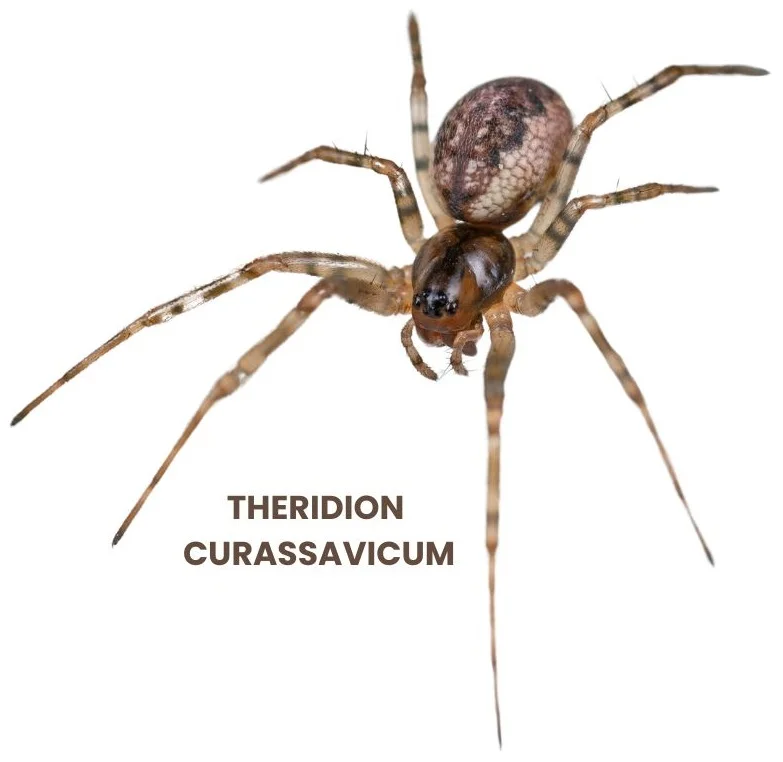Theridion Curassavicum, derived from the Orange-Spider, is a powerful homeopathic remedy, particularly effective for treating nervous hypersensitivity, especially to noise, and conditions related to tubercular diathesis, such as scrofula and phthisis (tuberculosis).
It is also helpful in cases of vertigo, sick headaches, and various other complaints, notably when symptoms are worsened by motion or sound.

SOURCE INFORMATION
Scientific Classification
- Kingdom: Animalia
- Order: Araneae
- Family: Theridiidae
- Genus: Theridion
- Species: Theridion curassavicum
Origin and Historical Facts
- Theridion Curassavicum originates from the Caribbean and South America, where the small orange spider lives.
- It became notable in homeopathy for its specific action on the nervous system, especially in cases where noise causes an exaggerated response.
- The remedy has been used historically to treat conditions like seasickness, vertigo, and sensitivities to noise, as well as to address tuberculosis symptoms when other remedies fail to hold long-term results.
DRUG PATHOGENESIS
- This remedy acts primarily on the nervous system, causing a hypersensitive reaction to stimuli such as noise, pressure, and motion.
- Patients often experience vertigo, nausea, and sharp pains.
- It also acts on the respiratory and digestive systems, causing discomfort in the chest, stomach, and spleen.
PHYSICAL CONSTITUTION, DIATHESIS, AND TEMPERAMENTS
- Physical Constitution: Suited for individuals with heightened sensitivity to noise, motion, or pressure.
- Common in individuals suffering from tubercular conditions and rachitis (a form of softening of the bones).
- Diathesis: Tubercular diathesis; those prone to scrofula, phthisis, and necrosis.
- Temperament: Restless, anxious, and overly sensitive, both physically and mentally.
- Often finds no pleasure in daily activities, with a feeling that time is passing too quickly.
WHAT IS CONSTITUTION IN HOMOEOPATHY?
WHAT IS DIATHESIS IN HOMOEOPATHY?
WHAT ARE TEMPERAMENTS IN HOMOEOPATHY?
KEY CHARACTERISTICS
- Hypersensitivity to Noise: Sounds are perceived as penetrating the body, causing pain, especially in the teeth.
- Vertigo and Seasickness: Dizziness accompanied by nausea and vomiting, worse on motion or closing eyes.
- Respiratory and Cardiac Symptoms: Pain in the chest, particularly the left side, and cardiac anxiety.
- Bone and Skin Sensitivity: Stinging pain in bones and skin, especially around the spine.
DETAILED ORGAN SYMPTOMS
MIND
- Restlessness with an inability to find joy in anything.
- A perception that time passes too quickly, contributing to mental distress.
HEAD
- Vertigo: Intense dizziness, especially on motion or when closing the eyes, often accompanied by nausea and vomiting.
- Headache: Throbbing pain, particularly over the left eye. Aggravated by motion, such as someone walking on the floor.
EYES
- Sensitivity to light with visual disturbances, such as luminous vibrations.
- A feeling of pressure behind the eyeballs, contributing to headaches.
NOSE
- Yellow, thick, offensive discharge from the nose, commonly associated with ozena (chronic atrophic rhinitis).
STOMACH
- Nausea and Vomiting: Seasickness-like nausea, worsened by motion or closing the eyes.
- Stinging pain over the left side of the spleen and burning sensations in the liver region.
RESPIRATORY
- Pain in the upper left chest, particularly in the region of the left floating ribs.
- Anxiety and pain in the cardiac region, with pinching sensations in the left pectoral muscle.
BACK
- Sensitivity between the vertebrae, particularly avoiding any pressure on the spine. Stinging pains are frequent.
SKIN
- Stinging, thrusting sensations across the body, especially on the thighs. Itching and sensitivity of the skin.
MODALITIES
Worse
- Touch, pressure, noise, and jarring movements.
- Being on a ship, riding in a carriage, or engaging in sexual intercourse (coitus).
- Left side of the body.
- Closing the eyes.
Better
- Lying still or avoiding motion. Warmth may also alleviate some symptoms.
WHAT ARE MODALITIES IN HOMOEOPATHY?
RELATIONSHIP WITH OTHER DRUGS
Compare with:
- Tabacum: Similar symptoms of seasickness, nausea, and vertigo.
- Pulsatilla and Thuja: For similar nasal and respiratory symptoms, especially for chronic nasal catarrh and ozena.
- Myrtus, Pix, and Anisum: For respiratory pains, particularly in the left side of the chest.
DOSE
- General Use: The thirtieth potency is commonly recommended for most cases, especially when dealing with hypersensitivity and nervous complaints.
Frequently Asked Questions
What is Theridion Curassavicum used for in homeopathy?
- It is used for treating hypersensitivity to noise, vertigo, seasickness, and tubercular conditions like scrofula and phthisis.
How does Theridion help with vertigo?
- It addresses vertigo that worsens with movement and is often accompanied by nausea and vomiting, especially when closing the eyes.
Is Theridion effective for seasickness?
- Yes, Theridion is particularly effective in treating nausea and vomiting caused by motion sickness.
What are the common symptoms indicating Theridion use?
- Common symptoms include hypersensitivity to sound, vertigo with nausea, cardiac pain, and stinging sensations in the skin and bones.
How is Theridion dosed?
- The most common dosage is in the thirtieth potency, but this can vary depending on the severity and specifics of the condition.
Glossary of Difficult Words
- Phthisis: A term for tuberculosis, particularly affecting the lungs.
- Scrofula: A form of tuberculosis affecting the lymph nodes, especially in the neck.
- Rachitis: Also known as rickets, a condition that causes the softening and weakening of bones in children, usually due to vitamin D deficiency.
- Caries: Decay in the bones or teeth.
- Necrosis: The death of body tissue, often due to lack of blood flow.
- Ozena: Chronic atrophic rhinitis, a condition where the nasal passages become dry and crusty, often leading to a foul-smelling discharge.
- Formication: A sensation that resembles insects crawling on or under the skin.

Well written medicine I have ever found on theridion curassavicum I like this writings.